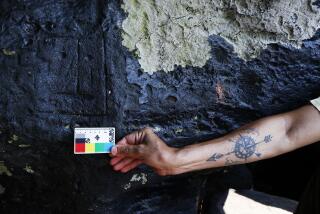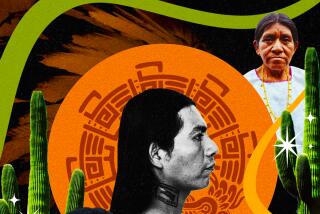Linguist Looks to Spoken Record to Provide Clues
- Share via
BELEM, Brazil — Deep in the Amazon rain forest, Denny Moore is unearthing clues that could yield important information about life in prehistoric South America.
Instead of a pick or shovel, Moore uses a tape recorder.
An anthropological linguist from Midland, Mich., Moore is racing to catalog and analyze the languages of Brazil’s vanishing Indian tribes. As Western civilization encroaches on the jungle and its inhabitants, many languages are on the verge of extinction.
“Brazil has 41 languages with fewer than 50 speakers, and a lot of those only have two or three surviving speakers. In other words, one or two people could hold the answers to very important questions,” said Moore, a trim, sandy-haired man who looks younger than his 56 years.
Indian artifacts and state-of-the-art technology mix easily at his office in Belem, a teeming port at the mouth of the Amazon River where Moore has pursued his quest in relative anonymity for 13 years. The MacArthur Foundation gave him a prestigious genius award in 1999, and the $365,000 prize helps keep the project going.
Moore is in it for the love of linguistics and a greater understanding of the universal properties of language. But his research also is helping piece together a picture of Amazon prehistory.
Because physical evidence is scant, little is known about the early peoples of the Amazon. By studying how words evolved from a root language, linguists can get an idea of how cultures developed here as early as 8,000 years before European explorers arrived in the 16th century.
For example, in Brazil’s Tupielated languages, there are words that appear to be 3,000 to 4,000 years old for manioc, sweet potato, field and digging stick. That suggests tribes were familiar with agriculture long ago--a big step for the simple hunters who first arrived in the Americas.
Other clues come from similar-sounding words that one language borrows from another. The words for corn or maize show how the plant spread since its introduction 2,000 years ago.
Moore has done most of his fieldwork in the western Amazon state of Rondonia, where five of Brazil’s 10 Tupian language families are spoken. He thinks Rondonia was the center of Tupian culture before the people dispersed, although he doesn’t have enough data yet to say how or when they got there.
One tantalizing discovery is that there is less language variation in the north--the opposite of what could be expected if the original settlers moved southward from the equator. Still, Moore says, without more information from neighboring Colombia, Venezuela and Bolivia, any theory is mere speculation.
For now, he has more than he can handle in Brazil alone.
The country has 180 Indian languages and 20 major dialects, with only about 18 active doctorate-level linguists working on analysis and description.
Some groups live in uncharted regions of the 2 million square miles of the Amazon and have never had contact with Western civilization. “You know, the kind of native groups that still shoot people and eat them,” Moore said, not entirely joking.
It doesn’t help that Moore has a tin ear and struggles to grasp subtle tonal differences that can change the meaning of words. That’s where his native guides are invaluable.
Once, Moore said, he was stumped for three weeks by the tone system of the Gaviao language. Then he saw the Indian who was helping him pick up his hat and whistle something.
“I realized he was whistling the tone for the word ‘hat,’ ” Moore said. “He had figured out my problem and was making the tone easy to hear by whistling it. There were three tones--high, low and rising.”
Moore also runs an innovative program to train young Brazilians as linguists. Until recently, most of the linguistic work in the Amazon was done by missionaries, who were there principally to spread Christianity.
“Their strong point is the amount of time they spent in the field,” Moore said. “But their main interest is translating the Bible, which doesn’t tell us a great deal about prehistory.”
Since 1987, Moore has sent 11 Brazilian students abroad to train at universities like MIT, Rice and UC Santa Barbara. Six others went to graduate schools in Brazil.
There can be more challenges in the jungle than just learning a language.
Moore told the story of one young Brazilian, now doing PhD work at the University of Arizona, who was studying the language of a Carib tribe famous for having massacred all but one of the members of five government teams that first attempted contact in the 1970s.
The tribe liked her so much they would not let her leave, Moore said. She had to wait until the Indians were drinking at a festival, then slipped off into the jungle and walked for three days to get to the nearest road.
Most tribes are easier going, Moore said. They like to have linguists create a writing system for them so they can record their culture and language. So far, Moore and his students have developed written systems for seven languages.
Moore would like someday to compile 10 hours of digital video recordings of each language as an emergency backup and store the data as indexed computer files.
But such a project would require development of a video index system capable of calling up recordings of similar words across hundreds of hours of tapes. Moore thinks the solution could depend on Silicon Valley taking an interest in the languages of the jungle.






